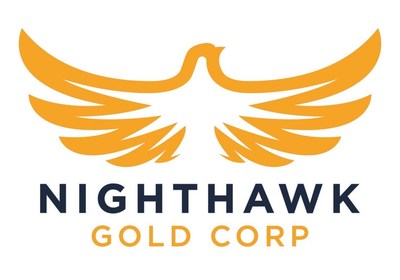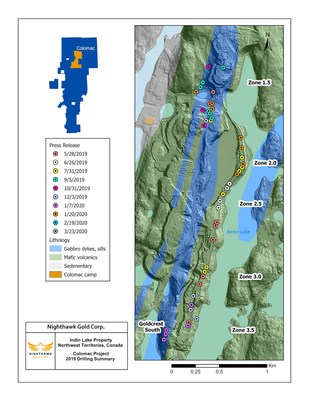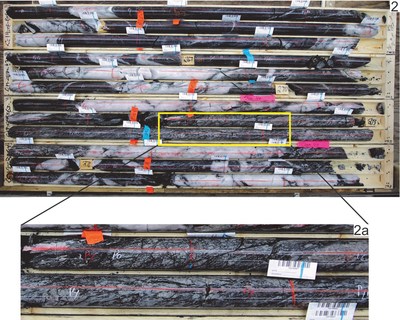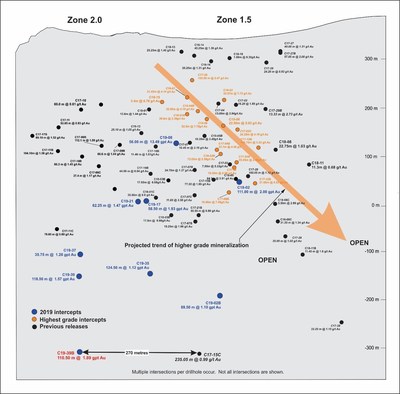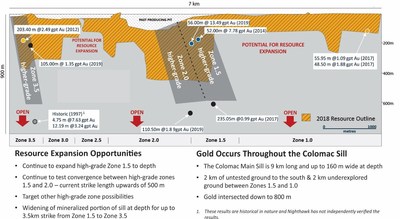Nighthawk 2019 Drilling Summary Sheds New Light on Colomac and Highlights Key Deliverables
TORONTO, May 20, 2020 /CNW/ - Nighthawk Gold Corp. ("Nighthawk" or the "Company") (TSX: NHK; OTCQX: MIMZF) is pleased to provide the following summary of its successful 2019 exploration program on its flagship Colomac Gold Project ("Colomac") centrally located within its Indin Lake Gold Property, Northwest Territories, Canada. The Company highlights key deliverables for the project moving forward and provides an update for 2020.
Dr. Michael Byron, President and CEO commented, "Last year was our most active and successful exploration program to date. We accomplished a tremendous amount, with our greatest achievements centred around the discovery that a panel of higher-grade mineralization exists spanning Zone 1.5 and the northern section of Zone 2.0, and of its three-fold increase in true width to upwards of 155 metres at depth. Equally as important was the discovery that the main body of the intrusion between Zone 1.5 and Zone 3.5 also shows a significant widening of the mineralized upper portion of the sill to depth, in excess of 3.5 kilometres along strike delivering another previously unknown opportunity that is expected to add to our resource expansion goals. These are just two of the many key deliverables achieved in 2019 that collectively establish an exciting path for Nighthawk going forward."
2019 Highlights and Key Deliverables:
- Most extensive and successful drill program completed to-date at Colomac, including the Colomac main sill ("Colomac Main") and the Goldcrest sill ("Goldcrest")
- Completed 91 drillholes for a total of 35,018 metres of drilling.
- Drilling continued to intersect significant grade over broad true widths within high-grade Zone 1.5
- Hole C19-08 returning the best intercept to date of 56.00 metres of 13.49 grams per tonne ("gpt") gold ("Au") hosted by a fluidized breccia – a newly recognized and highly mineralized phase within the mineralized quartz diorite portion of the sill.
- Newly defined panel of mineralization exhibiting strong continuity, formed by the merger of high-grade Zone 1.5 and the northern portion of Zone 2.0
- Traced up to 500 metres in strike with a true width of 30 metres to 50 metres at shallow depths and progressively expands to upwards of 155 metres in true width at 800 metres vertical depth where it remains open.
- Breakthrough Discovery - mineralized portion of the Colomac Main widens upwards of three-fold to depth throughout the best mineralized section of the Main sill (Zone 1.5-2.0 Panel)
- This represents one of the greatest advances made to-date at Colomac, and highlights this area for its potential to host significant tonnes of high-grade mineralization over extraordinary true widths, thus presenting a new opportunity for underground bulk mining as a possible means of future exploitation.
- Confirmation that the mineralized portion of Colomac Main widens significantly to depth throughout the 3.5 kilometres that separates Zone 1.5 from Zone 3.5
- It is believed that this progressive widening to depth reflects the sill's true geometry and is typical of its entire 9-kilometre strike length, thus providing a new and exciting opportunity for significant resource expansion at depth.
- New style of Colomac high-grade quartz vein hosted mineralization documented at Zone 3.5 outside of the quartz diorite
- Intersected mineralization within the intrusion's basal quartz gabbro representing a new style of mineralization that requires additional follow-up.
- Drilling targeted new resource expansion opportunities within Goldcrest's southern section
- Metallurgical testwork continues to characterize Colomac rock as extremely consistent and predictable in terms of hardness and response to standard gold recovery processes
- Continued streamlining of operational efficiencies have led to reductions of all-in drilling costs to $286 per metre
The 2019 drill season commenced in early March 2019 and ran until late September with three drills active. A total 110 drillholes for 40,834 metres of drilling was completed with the majority of drilling focused at Colomac (35,018 metres), in preparation for an updated mineral resource estimate in 2020. Drilling at Colomac continued to: delineate discrete higher-grade domains within Colomac Main along strike and to new depths; explored for new zones similar to Zone 1.5 throughout Colomac Main and Goldcrest; infilled and tested the boundary area between Zones 1.5 and 2.0; and drilled shallow gaps in the resource from Zone 3.5 northwards to Zone 2.0, a region that remains largely underexplored to depth (Figure 1).
Seven (7) holes (2,190 metres) were completed at Goldcrest, located parallel and 400 metres west of Colomac Main, to follow-up on areas highlighted by Nighthawk's three previous drill campaigns, and to target new resource expansion opportunities to depth within Goldcrest's southern section ("Goldcrest South").
Colomac Higher-Grade Zones
The ongoing frequency of expansive intersections, their significant true widths, and continuity of higher-grade mineralization intersected within the targeted zones continues to enhance project fundamentals. Since the discovery of higher-grade mineralization at Zone 1.5 in 2014, this area has remained the focus of systematic drill activity that ultimately lead to the zone's well-defined strike and depth extents, and recognition of its prominent three-fold expansion of true width to depth. Success at Zone 1.5 has helped enormously in the understanding of the key structural factors responsible for the localization of such higher-grade domains. This knowledge has been deployed elsewhere throughout the sills to help delineate other higher-grade prospects such as Zones 2.0 and 3.5, and in the exploration for additional discoveries.
Zone 1.5 Advancements
Zone 1.5 continues to deliver outstanding results as shown by its capacity to host exceptional gold grades over incredible widths. Early in the 2019 campaign hole C19-08 was drilled 75 metres south of the high-grade discovery hole C14-06 (see press release dated December 3, 2014) to infill a gap in drill coverage at shallow depths. It intersected an intensely mineralized region 240 metres below surface that returned the best gold values reported to-date at Colomac, intersecting 56.00 metres of 13.49 gpt Au, including 30.50 metres of 22.12 gpt Au, and including 16.50 metres of 34.18 gpt Au, and including 10.00 metres of 53.57 gpt Au. The intersection is double the deposit's previous best intercept, and the reason for this remarkable difference may be a function of the unique textural nature of the sill in this localized area.
The host rock represents a newly recognized phase within the quartz diorite, and its distinctive texture is presumed to be the reason for the localized and highly elevated grade. Figure 2 shows a 15.50 metre section of hole C19-08 that assayed 32.19 gpt Au. Inset Figure 2a is an enlargement of part of the photo and depicts the texture in question. The subangular breccia fragments of quartz diorite preferentially aligned in a common direction and cast in a very fine-grained matrix of pulverized quartz diorite suggest that a focused fluidization process was once active within this part of Zone 1.5. In some locations the matrix is intensely flow banded and wraps around larger fragments, clearly demonstrating its once fluid character. Fluidization refers to a mixture of solid particles suspended in a turbulent gas. This mixture is proposed to sand blast its way up a diatreme or "vertical pipe-like" feature enlarging its diameter and transporting blocks of stoped off country rock. Fluidization, which results in the rounding of fragments and the erosion of the pipe, is the operative stage, and the heightened permeability that such a process would invoke is probably responsible for the robust mineralization encountered in C19-08.
Areas of fluidized quartz diorite are now recognised as priority targets of extremely high-grade gold mineralization that occur as localized grade blowouts within the sill of limited areal extent.
Zone 1.5-2.0 Mineralized Panel
The breakthrough discovery of the sill's pronounced widening to depth at Zone 1.5, its best mineralized section, represents one of the principal advances made to-date at Colomac.
Drilling in 2019 was instrumental in establishing that an extensive panel of mineralization with strong continuity spans Zone 1.5 and the northern part of Zone 2.0, in effect linking them into a 500 metre long wedge shaped sheet with a near-surface true width of up to 50 metres that progressively expands to upwards of 155 metres in true width at 800 metres vertical depth where it remains open. (Table 1; Figure 3; see press releases dated December 3, 2019, January 20, 2020).
The recognition and delineation of this immense mineralized panel highlights this zone's potential for accommodating large tonnes of high-grade mineralization over exceptional true widths. This may represent a new opportunity at Colomac for underground bulk mining as a possible means of future exploitation of these unique higher-grade prospects. (Figure 4).
Table 1. 2019 Selected Drill Results – Zone 1.5-2.0 Mineralized Panel
Zone | Drill Hole | Assay Results | Summary |
2.0 | C19-24 | 56.25 m at 2.76 gpt Au | Extended mineralization to over 450 m vertical depth where it remains open |
including | 13.00 m at 3.51 gpt Au | ||
including | 4.25 m at 14.89 gpt Au | ||
1.5 | C19-35 | 124.50 m at 1.12 gpt Au | Tested area immediately north of the Zone 1.5-2.0 boundary and extended mineralization to 530 metres depth, where it remains open |
including | 13.50 m at 3.60 gpt Au | ||
Including | 4.75 m at 7.64 gpt Au | ||
2.0 | C19-39 | 118.50 m at 1.57 gpt Au | Tracked mineralization from near surface to a vertical depth of more than 550 metres where it remains open |
including | 32.50 m at 2.62 gpt Au | ||
including | 7.75 m at 5.10 gpt Au | ||
2.0 | C19-39B | 110.50 m at 1.89 gpt Au | Defines widening of mineralized portion of the sill to depth - true width grown to more than 110 metres at vertical depths of 700 metres below surface |
including | 57.00 m at 2.37 gpt Au | ||
including | 6.40 m at 5.16 gpt Au |
Widening of the Mineralized Portion of Colomac Main
In 2016, drilling at Zone 1.5 provided early evidence that the sill may be widening to depth (see press release dated October 12, 2016). This was followed up on in 2017 where drillhole C17-15C revealed that the mineralized portion of sill in this area has a "wedge shaped" form, where its true width expands three-fold to 155 metres at vertical depths of 800 metres (see press release dated September 18, 2017).
Drilling in 2019 showed that the true width of the sill at Zone 2.0 increases to more than 110 metres at vertical depths of 700 metres below surface. Clearly illustrating that the widening of the sill is not an isolated feature to Zone 1.5, as the entire Zone 1.5 - Zone 2.0 mineralized panel widens significantly with depth. Throughout the remainder of the 2019 program drilling was carried out within the 3.5-kilometre section of the sill between Zone 1.5 in the north and Zone 3.5 to the south (Table 2) to determine the sill geometry to depth. Results have confirmed that the mineralized top portion of the sill widens to depth at Zones 3.5, 3.0, and 2.5, suggesting that a similar expansion to depth probably exists throughout its entire 9km strike length and represents the true morphology of Colomac Main (see press releases dated July 31, 2019, January 7, 2020, March 23, 2020). This discovery represents the greatest potential for resource growth ever identified at Colomac.
Table 2. 2019 Selected Drill Results – Colomac Main Zones 2.5, 3.0, 3.5
Zone | Drill Hole | Assay Results | Summary |
2.5 | C19-47B | 37.75 m at 1.29 gpt Au | Traced uniform and expansive mineralization from near surface to 260 m depth where it remains open and unconstrained |
including | 24.25 m at 1.61 gpt Au | ||
including | 9.25 m at 2.22 gpt Au | ||
3.0 | C19-25C | 29.50 m at 2.78 gpt Au | Trace mineralization on undrilled section – broad mid-level intercept extended mineralization to depth over 250 m where it remains open |
including | 16.20 m at 4.06 gpt | ||
including | 3.80 m at 6.86 gpt Au | ||
3.5 | C19-50 | 105.00 m at 1.35 gpt Au | Intersected 170.00 m downhole mineralization for a true width of 71.00 m at 350 m depth (double the near surface true width) |
including | 34.50 m at 2.38 gpt Au | ||
including | 12.75 m at 3.23 gpt Au |
New Style of Mineralization Discovered at Zone 3.5
Two holes drilled at the southern end of Zone 3.5 within a previous unexplored area intersected shallow high-grade mineralization outside and west of the quartz diorite portion of the sill. Holes C19-38 and C19-38B were drilled to test the projected up-plunge extension of Zone 3.5 mineralization south of previous drilling (see press release dated December 3, 2019). Both holes intersected shallow high-grade mineralization hosted by quartz veins and represent the first documented occurrence of this new style of mineralization below the quartz diorite upper portion of the sill within the intrusion's basal quartz gabbro (Table 3). Given the shallow depths of the intercepts and their high-grade nature, additional work is needed to trace and ultimately determine if this represents a dynamic new target opportunity.
Table 3. 2019 Selected Drill Results – Zone 3.5 Discovery
Drill Hole | Assay Results |
C19-38 | 11.20 m at 4.41 gpt Au |
including | 6.60 m at 7.09 gpt Au |
Including | 3.75 m at 12.19 gpt Au |
C19-38B | 9.00 m at 1.94 gpt Au |
including | 5.25 m at 3.04 gpt Au |
And | 6.00 m at 3.24 gpt Au |
including | 3.00 m at 6.24 gpt Au |
Resource Expansion Opportunities at Goldcrest South
Goldcrest is a 2.5-km long mineralized differentiated intrusion 400 metres west and parallel to Colomac Main. Both sills are believed to be co-magmatic and have intruded a package of dominantly mafic volcanic rocks that were subsequently folded upright such that stratigraphic tops are now facing east. Gold mineralization is largely restricted within the more silica-rich upper portions of the sills. Goldcrest is comprised of two main regions of mineralization: Goldcrest South and Goldcrest North.
Goldcrest has been drilled significantly less than Colomac Main (last drilled in 2017), but several key areas remain underexplored as illustrated by the high-grade intercept in hole C19-05 (see press release dated February 19, 2020). This hole was drilled within a previously untested area of the sill and traced strong mineralization to new depths, opening this part of the sill for continued resource growth (Table 4). All 2019 holes intersected gold mineralization over a strike length of 400 metres within Goldcrest South, thus the potential for new discoveries remains high. Ongoing success in locating and expanding new higher-grade zones within Goldcrest offers strong support for resource expansion opportunities going forward.
The Company has now completed four drill programs at Goldcrest (2014, 2016, 2017 and 2019), yet large portions of the sill remain unexplored to depth and along strike to the south, as well as within the northern portion of Goldcrest, and the 800-metre section that separates Goldcrest South and Goldcrest North, which are prime targets for resource expansion.
Table 4. 2019 Selected Drill Results – Goldcrest South
Drill Hole | Assay Results | Summary |
C19-05 | 68.50 m at 2.00 gpt Au | Subvertical hole drilled down the sill in an open area between two previous Nighthawk holes to explore the zone to depth and intersected 130 m of relatively continuous downhole mineralization throughout a 20.00 m true width to a vertical depth of 153 m where it remains open |
including | 15.50 m at 5.47 gpt Au | |
including | 4.25 m at 16.98 gpt Au | |
And | 15.25 m at 1.77 gpt Au | |
including | 4.00 m at 5.31 gpt Au | |
And | 16.25 m at 1.46 gpt Au | |
including | 1.50 m at 9.25 gpt Au |
Improved Costs
Drilling efficiencies continued to improve in 2019. Three diamond drills serviced by one helicopter completed 110 holes and resulted in a 15% reduction in all-in drilling costs to $286 per metre, for 2019.
Ongoing Metallurgical Test-work
The Company continues to conduct metallurgical testwork which continued to show that Colomac rock performs exceptionally well in terms of its grind characteristics, purity, and responsiveness to all standard gold recovery technologies with recoveries of upwards of 98.0% using a combination of gravity and cyanide leach recovery processes. Although the ongoing heap leach bottle roll and column tests are still at a preliminary stage, results show a favourable response to the deposit's heap leach potential (see press release dated April 23, 2020).
Future work will also continue scrutinizing the heap leach potential of the Colomac deposit. The main objective is to confirm that the metallurgical responses observed so far will apply over a broader range of head grades, zone locations, and depths within the deposit.
2020 Exploration Plans
The Company announced a planned 25,000-metre drill program which commenced on March 13, 2020 with three drills. On March 27, 2020, the Company announced a temporary suspension of exploration activities on its Indin Lake Gold Property due to the rapidly changing environment surrounding the Covid-19 pandemic. All camp personnel were sent home and the camp was officially closed on April 5, 2020. A total of 2,598 metres of drilling was completed at Colomac and the Leta Arm Gold Project before the suspension of drilling activities.
The Company is hopeful that exploration activities can resume before the end of summer 2020 to allow for the completion of the remaining flow-through commitment. Ongoing metallurgical testwork, preparation of an updated mineral resource estimate, and the subsequent preparation of an internal scoping study have not been affected by the pandemic. Any additional updates will be provided as they become available.
Nighthawk's goals and objectives moving forward include:
Colomac
- Delivery of an updated mineral resource estimate
- Provide an open pit constrained resource to establish a higher level of confidence and economic potential
- Examine both open pit and higher-grade underground resource opportunities
- Conversion of some inferred resources to indicated resources
- Metallurgical testwork on additional areas within the sill to assess potential variabilities and overall expected recoveries and to generate a sound statistical framework for the heap leach opportunity
- Complete internal scoping studies to assist with future exploration activities, which could potentially provide the base work for any future PEA
- Continue drilling throughout the 9km long Colomac Main and Goldcrest (~4km long) to follow up on resource expansion opportunities and to explore for additional higher-grade areas
Regional Targets
- Preparation of a maiden mineral resource estimate for the Damoti Lake Gold Deposit
- Continue to test high-priority regional targets to advance them up the value chain
- Continue regional prospecting work to identify new targets and prioritize existing preliminary targets to drill-ready status
Technical Information
Nighthawk has implemented a quality-control program to comply with best practices in the sampling and analysis of drill core. Drill core samples were transported in security-sealed bags for analyses at ALS Global Assay Laboratory in Vancouver, BC ("ALS Global"). ALS Global is an ISO/IEC 17025 accredited laboratory. Pulp and metallics assaying for gold was conducted on the entire pulverized sample.
As part of its QA/QC program, Nighthawk inserts external gold standards (low to high-grade) and blanks every 20 samples in addition to the standards, blanks, and pulp duplicates inserted by ALS Global.
About Nighthawk
Nighthawk is a Canadian-based gold exploration company with 100% ownership of a district-scale land position within the Indin Lake Greenstone Belt, located approximately 200 km north of Yellowknife, Northwest Territories, Canada. Nighthawk is focused on advancing the Colomac Gold Project with a current inferred resource of 2.6 million ounces of gold (50.3 million tonnes at an average grade of 1.62 grams per tonne gold), as well as advancing its other regional gold deposits and showings within this largely underexplored Archean gold camp.
The Company has an experienced and dedicated team and is well funded to complete its goals and objectives over the next 12 months.
Qualified Person
Dr. Michael J. Byron, Ph.D., P.Geo., President & Chief Executive Officer of Nighthawk, who is the "Qualified Person" as defined by NI 43-101 for this project, has reviewed and approved of the technical disclosure contained in this news release. Please refer to NI 43-101 technical report "Technical Report and mineral resource estimate update on the Colomac Property of the Indin Lake Project", dated June 13, 2018, as filed under the company's profile on www.sedar.com.
Neither the Toronto Stock Exchange has neither reviewed nor accepts responsibility for the adequacy or accuracy of this news release.
Forward-Looking Information
This news release contains "forward-looking information" within the meaning of applicable Canadian securities legislation. Forward-looking information includes, but is not limited to, information with respect to the Company's continued exploration programs (including size and budget) and the ability to advance targets and conduct enough drilling to produce NI 43-101 compliant resource estimates, and the timing and results thereof; the ability to grow ounces at Colomac, as well as the ability to calculate indicated resources for zones 1.5 and 3.5, and the timing and results thereof; the ability to conduct additional metallurgical testwork and the timing and results thereof; preparing an internal scoping study and utilizing its findings as a basis for any future preliminary economic assessment and the timing surrounding such a project; the ability to raise the necessary capital on acceptable terms in order to conduct exploration programs including mapping, prospecting and drilling activities and identify new targets in future years, as well as any intention to expand these programs in the future. Generally, forward-looking information can be identified by the use of forward-looking terminology such as "plans", "expects", or "does not expect", "is expected", "budget", "scheduled", "estimates", "forecasts", "intends", "anticipates", or "does not anticipate", or "believes" or variations of such words and phrases or state that certain actions, events or results "may", "could", "would", "might", or "will be taken", "occur", or "be achieved".
Forward-looking information is based on the opinions and estimates of management at the date the information is made, and is based on a number of assumptions and is subject to known and unknown risks, uncertainties and other factors that may cause the actual results, level of activity, performance or achievements of Nighthawk to be materially different from those expressed or implied by such forward-looking information, including risks associated with the exploration, development and mining such as economic factors as they effect exploration, future commodity prices, changes in foreign exchange and interest rates, actual results of current exploration activities, government regulation, political or economic developments, environmental risks, permitting timelines, capital expenditures, operating or technical difficulties in connection with development activities, employee relations, the speculative nature of gold exploration and development, including the risks of diminishing quantities of grades of reserves, contests over title to properties, and changes in project parameters as plans continue to be refined as well as those risk factors discussed in Nighthawk's annual information form for the year ended December 31, 2017, available on www.sedar.com. Although Nighthawk has attempted to identify important factors that could cause actual results to differ materially from those contained in forward-looking information, there may be other factors that cause results not to be as anticipated, estimated or intended. There can be no assurance that such information will prove to be accurate, as actual results and future events could differ materially from those anticipated in such information. Accordingly, readers should not place undue reliance on forward-looking information. Nighthawk does not undertake to update any forward-looking information, except in accordance with applicable securities laws.
![]() View original content to download multimedia:http://www.prnewswire.com/news-releases/nighthawk-2019-drilling-summary-sheds-new-light-on-colomac-and-highlights-key-deliverables-301062329.html
View original content to download multimedia:http://www.prnewswire.com/news-releases/nighthawk-2019-drilling-summary-sheds-new-light-on-colomac-and-highlights-key-deliverables-301062329.html
SOURCE Nighthawk Gold Corp.

![]() View original content to download multimedia: http://www.newswire.ca/en/releases/archive/May2020/20/c8273.html
View original content to download multimedia: http://www.newswire.ca/en/releases/archive/May2020/20/c8273.html
